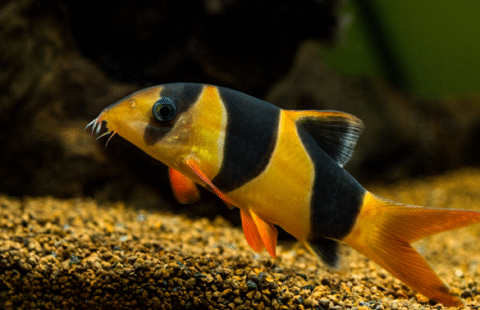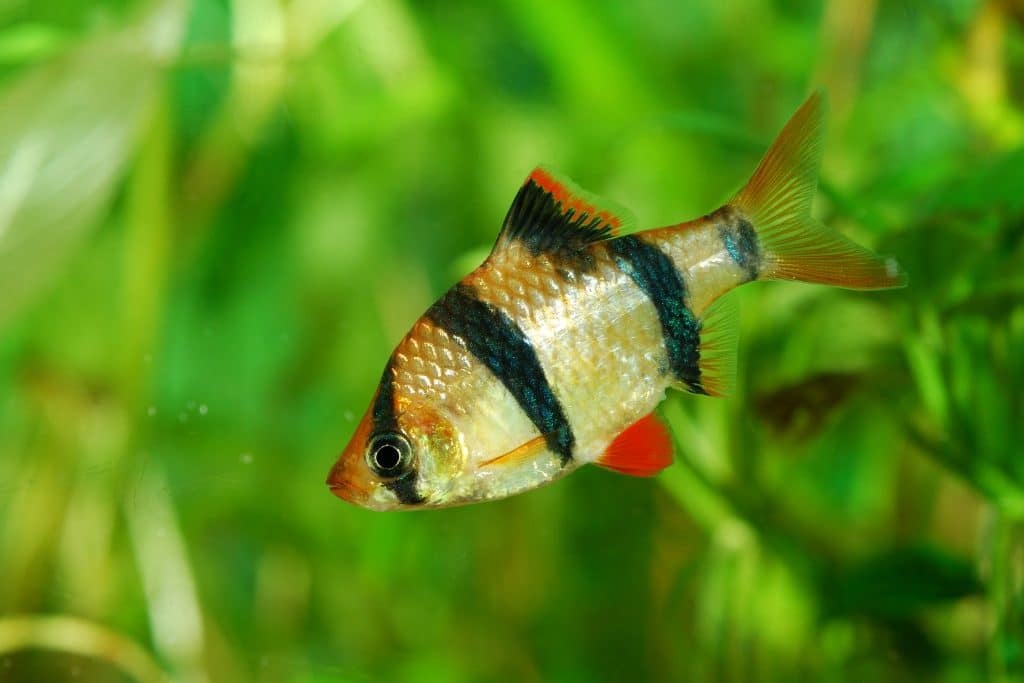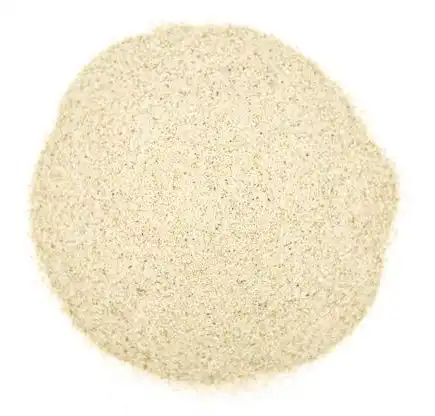Thank you for visiting! By the way… any links on this page that lead to products on Amazon and other stores/partners are affiliate links Aquarium Store Depot earns a commission if you make a purchase.
If you haven’t enjoyed being entranced by a colorful and playful fish, let us introduce you to clown loaches. These peaceful freshwater creatures are popular with aquarists for their one-of-a-kind look and activities. As such, it is essential that potential owners learn about keeping them before venturing out into getting one – including tank setup, water parameters, compatible tank mates, etc.
Our thorough guide on how to care for the clown loach covers everything from origins & history, life span & size, feeding tips, and breeding info all the way down to health issues associated with this species. Get ready as we dive deep into discovering these extraordinary aquatic animals!
Key Takeaways
- Clown loaches are visually stunning, social fish that require experienced aquarists and should be kept in groups of 6+
- To ensure their health & happiness, provide them with a 75 gallon tank (125 recommended) setup including sandy substrate mixed with small rocks/pebbles/gravel along w/ live plants, driftwood & caves.
- Regular water changes and monitoring of parameters such as pH, hardness, and temperature is essential to maintaining a healthy environment for clown loaches.
Species Overview
| Scientific Name | Chromobotia macracanthus |
| Common Names | Clown Loach, Tiger Botia |
| Family | Botiidae |
| Origin | Indonesia (Borneo and Sumatra) |
| Diet | Omnivorous |
| Care Difficulty | Intermediate |
| Activity | Active |
| Life Expectancy | 10 – 15 years |
| Temperament | Peaceful |
| Tank Level | Bottom Of The Tank |
| Minimum Tank Size | 75 gallons (284liters) – recommended 125 gallons (473 liters) |
| Water Temperature Range | 75-86°F (24-30°C) |
| Water Hardness | 5-12 dKH |
| pH Range | 6.0 – 7.5 |
| Filtration/Water Flow | Moderate |
| Water Type | Freshwater |
| Breeding | Egg layers |
| Difficulty to Breed | Difficult |
| Compatibility | Community Tanks – but not with small fish |
| OK, for Planted Tanks? | Yes – but will dig up plants |
Introduction
Chromobotia macracanthus was also formerly known has Botia macracanthus until Dr. Maurice Kottelat created a new genus for them. They are more commonly known as clown loaches, are bottom dwelling fish from Southeast Asia that captivate the eye with their vibrant coloration. Unfortunately for beginners of aquarium keeping, they require large tanks and can be particularly prone to disease. For this reason, it is important to maintain at least six together in a shoal so they may perform natural actions such as playing around one another throughout the day – much like how these social species live naturally within hierarchies formed by an alpha female in its habitat.
Origins And History
Clown loaches, also called tiger botia, are native to the islands of Borneo and Sumatra in Indonesia. In their natural habitat, they inhabit tributaries within Malaysia, Borneo, Sumatra and Kalimantan with lightly-hued waters flowing through tropical rainforests. Unfortunately, due to human interference, these fish’s survival in the wild is threatened by poaching practices along with pollutants contaminating bodies of water as well as the destruction of vital habitats1.
Fortunately, the loaches you find at pet stores are all captive bred. Clown loaches are known primarily for both beauty plus personality traits that make them distinguishable from other breeds: vibrant colors accompanied by rare patterns cause captivation among aquarists prompting commercial breeding efforts mainly conducted at Singapore based fish farms via hormone injection methods.
Appearance

Clown loaches, with their brilliant yellowish-orange bodies and vivid red fins featuring a distinct three-banded pattern in the shape of a triangle, make an eye-catching presence in any freshwater aquarium. These bottom dwelling fish have an impressive lateral line system that helps them detect changes to water pressure as well as external predators using barbels on their snouts for assistance while scavenging for food.
Variations are known between regional clown loach populations, such as those from Borneo having extra black pigmentation on their fins compared to Sumatran ones though all share this stunning appearance which has made them so beloved among aquarists alike.
Lifespan
The average clown loach lifespan in captivity is around 10 years. If these little fish are given special attention and care, it can extend up to 20 or even 25 years. To ensure their health and a long life span, make sure that the aquatic environment they’re living in is free of pollutants with proper diet & water quality taken into account at all times. Clown loaches will be an amazing asset to your aquarium for many years thanks to the effort put forth when caring for them!
Average Size
When it comes to tank setup, a clowns’ eventual adult size should always be considered. Clown Loach Size in captivity is not to be underestimated — they can reach a size of up 12 inches! Providing them with the proper living space is vital since this active species needs enough room for its growth and behavior display. It’s important to note that when these fish increase in size you might need a larger tank, so make sure your set-up will meet their needs from day one onwards.
Clown Loach Care Requirements
For a clown loach to thrive, an appropriate environment must be provided. We’ll go through the necessary care essentials, including tank setup and water parameters for a healthy life of these bottom-dwelling creatures. It’s also crucial that they are kept in groups so their stress levels can reduce and natural behavior is exhibited – since they’re schooling fish, after all! It’s essential that you design your tank carefully with regard to the specific needs and preferences of the species.
Tank Size And Setup
When considering the number of clowns in your aquarium, a tank size of 75 gallons is recommended to house an adult. The walls should be at least 24 inches (60 cm) tall in order to provide enough room for them as they are active swimmers that need space to explore their surroundings.
Substrates such as sand mixed with gravel and small rocks create a natural environment that allows them the opportunity to seek out food by sifting through it. Add plants – both live, and floating ones – along with driftwood, caves, and stones contribute towards creating a visually appealing habitat where these fish can hide away from predators if needed. Keep in mind as they get larger, they will dig out some plants. It’s best to work with plants that do not need to be rooted.
Natural sand is excellent for bottom feeder fish to forage around in.
A big note here about these fish is that they need a large group to really come into their own, while 6 is often the recommended, you will get the minimum behavior from them with a small group from them. You will see them more active with a group of 12 and you will see them the most active when you can get a group of 30 or more. This requires a very large tank and is something to consider if you plan on keep these fish long-term.
Adequate filtration must be established: choose a canister filter that serves well to maintain high quality water levels. For larger tanks, you will need to consider a sump once you get past 150 gallons.
Water Parameters
Clown loaches prefer a soft water environment with pH between 6.0-7.5, dGH of 4-12 and a temperature range of 75-86°F (24-30°C). One thing missed in many blogs you will come across is that they will not touch upon how critical is it to have your temperature on the high end.
80-85 degrees is their preference. However, many other fish won’t tolerate that well. With high temperatures, you will encourage your clown loach to be more active. The higher temperature will also help prevent ich, which they are sensitive to. Given their need for high temperatures, an aquarium heater is a must.
Best Aquarium Heater
Finnex has achieved what we as hobbyist have asked for decades. A reliable heater that won't fail. Japanese components. Receives our top recommendation.
To keep the fish tank healthy and ensure optimal living conditions for these freshwater fish, regular water changes are needed. The typical recommendation is replacing 30% of the total volume weekly to avoid any buildup of hazardous substances. However, always keep up with testing your water and only do water changes based on the parameters of your tank. Here are base parameters to maintain.
Note with these fish that pH is generally not an issue, they will adapt to a wide range, which allows them to house with fish on both extreme ends from Discus fish to African Cichlids.
Feeding And Diet
Ensuring your clown loach receive the right nutrients is important for their health and well-being. These omnivorous fish need both proteins as well as plants in order to be balanced, so it’s essential that you provide them with a variety of healthy meals.
Let’s go over a few things here. When your loaches are younger, they will pretty much eat anything. Look for foods such as:
- Bloodworms
- Blackworms
- Brine shrimp
- Pellets
As they get larger, it’s good to consider snails (which they will happily eat and eradicate in a tank), clams and mussels from the store. These fish get massive over time and when they get closer to their full size some fish food won’t suffice. You can also use Zucchini, which they will happily munch on. Watching them eat Zucchini is also a great way to observe their clicking noises when they eat.
Feeding Schedule
When it comes to your clown loach, setting up a proper feeding schedule is very important. Aim for multiple small meals throughout the day that they can finish in 1 minutes or less so as not to overfeed them. Observe their eating habits and adjust accordingly if necessary.
Note these are omnivores. Make sure to include vegetables and plant matter, which should make up approximately 30-40% of their diet.
Choosing Compatible Tank Mates

Your Clown Loach is generally a peaceful fish and best with other fish of similar demeanor. When choosing clown loach tank mates, consider they get very large and need community fish of similar size
I’ll go over obvious bad picks in the next section. For now let’s list out a few great picks:
- Tiger barbs
- Rainbowfish
- Gouramis
- Discus Fish – due to similar temperature preferences
Yes, this is one of the few fish that do great with tiger barbs; in fact, they complement each other perfectly!
Incompatible Species
When looking to form a balanced aquarium, it is important to consider the temperament and habitat requirements of other fish species when deciding on tank mates for your clown loach. Here are a few bad choices:
- Goldfish
- Bettas
- Territorial bottom-dwelling specimens
- Very aggressive fish like the Wolf Cichlid
- Small schooling fish
- Coldwater fish – as Clown Loach fish prefer warmer waters
Breeding
Breeding clown loaches is a task that can bring great rewards to the committed aquarist. In order for these fish to be able to reproduce, they must first reach sexual maturity and have access to appropriate conditions. This includes proper nutrition as well as an ideal tank setup. It is rare to breed this as an aquarist. Fish farms can achieve breeding due to the use of hormones. For a bit of an insider view, check out this video by Cory’s Team on how it is done.
Raising Fry
In order to raise healthy clown loach fry, it is necessary to pay close attention and provide the right care. After fertilization of eggs, adult clowns should be removed from the tank to not consume these newly formed eggs.
The young can feed on live insects cultured specifically for them such as brine shrimp or tubifex worms, along with ground fish flakes food that will nourish their development well and ensure a clean environment around them suitable for growth too. Check water parameters regularly since it plays an important role in keeping their health up so they can thrive properly.
Common Health Issues And Prevention
Clown loaches are particularly susceptible to Ich, an ectoparasite that can cause fungal and bacterial infections. This is due to their lack of scales compared with other fish species, making them more vulnerable. There are several ways to prevent Ich attacking your fish:
- Consider quarantining this fish – because of their scaleless nature they are harder to medicate
- Keep temperatures high – this is their preference and also keeps ich at bay
- Keep dimmer lights or consider introducing tannins, they replicates their natural environment
To ensure the health of your aquarium, it is important to monitor water parameters regularly as well as perform frequent partial water changes. If you encounter a case of Ich infestation in clown loaches, remove them immediately from the main tank and place them in quarantine for treatment. They will not do well with some medications so do your research!
These fish are also one fo the first fish to pass during a power outage since they do not tolerate cold that well. Make sure you have a power outage plan and back up options to keep your heat going if you have an outage. Since heaters are the highest draw of an aquarium when in use, you will need to step up your back up plan with generators or high volt battery backups!
Frequently Asked Questions
How many clown loaches should be kept together?
Clown loaches need to live in groups of at least six as they are highly social creatures and get along with other non-aggressive fish species. For them to have enough space for swimming around actively, an ample tank should be provided. It is also essential that a good filtration system be put into practice so the water remains healthy and clean for your clown loach. You will see them at their most social in a group of 30+. However, most hobbyists cannot accommodate a tank that large to fit that many at full size.
How big will a clown loach get?
Clown loaches are known to reach an impressive length. Many aquarists have reported Adult Clown Loaches up to 30 cm (11.8 in), although these fish typically grow to 15-20 cm (5.9–7.9 in). It is necessary for owners of this large species of fish to provide enough room for them to swim around comfortably inside the tank!
How long do clown loaches live in captivity?
Clown Loaches are able to survive for a decade in an aquarium, while their longevity may even reach up to 25 years when conditions are optimal.
What is the ideal tank size for a single adult clown loach?
An adult clown loach needs a minimum tank size of 75 gallons to be properly housed. You should consider stepping up to a 125 gallon or up as a recommendation.
What should I feed my clown loaches?
Provide your clowns with a nutritious diet, including sinking pellets and flakes along with live or frozen items such as earthworms, bloodworms, clams, and mussels. Vegetables like cucumber, zucchini, and spinach (blanched) should also be included to make sure they get all the needed nutrients. Variety is key to optimal health!
Closing Thoughts
This clown loach care guide has all the information you need to create a healthy and happy home for these unique fish. Starting from their origins, appearance, and environmental requirements. Continuing with balanced diet selection, compatible tank mates determination plus breeding tips as well as addressing common health issues, everything is explored so that caring for your clown loach becomes simpler than ever before. If you looking for smaller loaches, check out our loach species guide.
You are now ready to embrace this captivating challenge of looking after your very own pair or group of lively clowns! Enjoy having such delightful companions in your aquarium – they will surely bring lots of fun into it!
- About the Author
- Latest Posts
I’m thrilled that you found Aquarium Store Depot! Here you’ll find information on fish, aquariums, and all things aquatics related. I’m a hobbyist (being doing this since I was 11) and here to help other hobbyists thrive with their aquariums! I adhere to a high quality Editorial Process and Review products with real life field usage and practical analysis.







